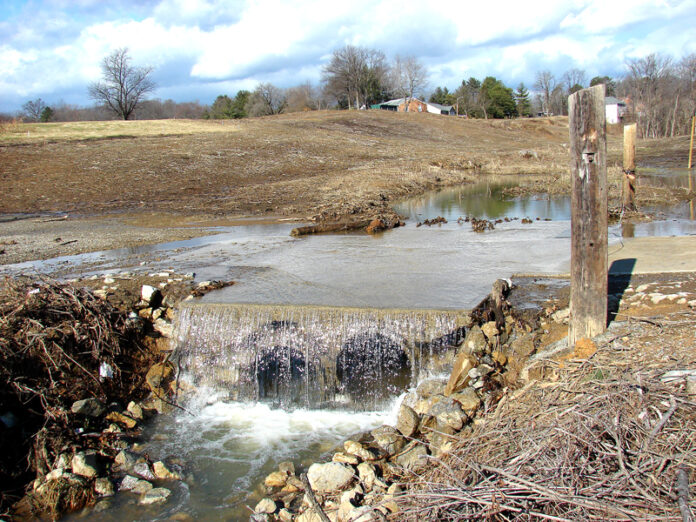
Roanoke City faces new stormwater quality mandates from the U.S. Environmental Protection Agency. “It is their number one enforcement priority,” said Phil Shermer, engineer for Roanoke City.
But the City continues to feel the effects of mandates with no funding attached. Funding for the water quality mandates “trickles down” to the state, then to the locality to implement and fund. The estimated cost to comply is $70 million.
Mayor David Bowers said the cascading effect is “coming down from the holy city of Richmond.”
Virginia’s Department of Environment Quality assesses the streams and the Virginia Department of Recreation and Conservation enforces the regulations. The Roanoke Valley’s unique geographical features create a “funnel effect.”
Roanoke has thirteen major watersheds in the city and thirteen 100-year flood plains. Each watershed has a stream associated with it and nine of these are impaired, according to the DEQ. Impairment is a measure of sediment load and bacteria like e coli and arsenic. “If you take care of sediment you take care of all the other things,” said Shermer. Sediment comes from development sites and impervious surfaces like parking lots.
Water from the Roanoke River flows to the Albemarle Sound in North Carolina; Roanoke, as the upper basin, encompasses 500 square miles. Getting rid of the sediment before it hits the drains is key. [We want to] “keep it dispersed – spread it out,” said Shermer.
Councilman Ray Ferris asked how much was specific to Roanoke City. Shermer said, “We are going to be the ones held accountable and each individual locality has its own permit.”
The degradation of water quality comes from “everyday human living – litter, fertilizer, oil, pesticides, soil erosion, air and heavy metal,” explained Chris Blakeman, Roanoke City’s Environmental Manager.
The onset and force of intense storms wash accumulated pollutants into local streams and the Roanoke River in what is called a “first flush.” On the plus side, Roanoke has separate storm water and sewer systems, though there are still septic tanks and open ditches and culverts in the city.
In 1972 the Clean Water Act put the nation on a pollution discharge diet. All sources are assigned a portion of the diet or Waste Load Allocation (WLA). Roanoke has seven percent of that load.
“Roanoke has the highest repetitive flood loss insurance claims in Virginia,” said Shermer. The 100-year floods have a one-percent chance of occurring in any given year. These 1985 type events are not controllable. The intent of stormwater management is to address the two and ten-year floods.
Sudden extreme intense thunderstorms don’t reach the two-year flood level. “You just can’t handle that much water quickly,” said Shermer.
Roanoke participates in the National Flood Insurance program. The $70 million flood reduction project has helped to mitigate some of the flood danger. “There is not much else we can do,” said Bowers. Shermer agreed, saying the city should consider purchasing parcels in the floodplain to prevent development.
Roanoke City has the highest rating for its efforts in flood control. The “class 7” rating gives home and business owners a 15 percent reduction in flood insurance premiums.
Since 2003, localities under 100,000 population count must comply with the state-issued MS4 permit. “We are part of the diet,” said Blakeman. An MSR4 permit requires that the city assess and control all pollution sources and perform bi-annual “first flush” sampling of city-owned property.
There are thousands of inlets and pipes in the city that need to be looked at every six months. Pipes are needed where there are none and 367 existing pipes discharge into a stream or river. Every pipe will be regulated for pollutant load.
There are a total of 203 stormwater projects Valleywide. The top-ten projects are the “worst of the worst” totaling $3.6 million. The first project to complete engineering will be first to go to construction. “We don’t have all the resources available for all of it,” said Shermer.
Maintenance funding will need to increase tenfold to $1 million annually. City Manager Chris Morrill said you just “can’t build your way out of it … this is a program that never ends.”
Public outreach, engagement, compliance tracking and fee collection are some of the added overhead costs. Staff will have to be increased substantially.
On average other localities charge a $40 per capita fee to cover stormwater funding. Richmond has a graduated three-tier fee system. It is based on a home’s square footage. It starts out at $25 and tops at $70 annually for homes over 2400 square feet.
In 2013 the city will be required to test for PCBs. A single test will cost $1100. By July 1, 2014 localities will take over issuing permits and collecting fees.
“We don’t want to put Roanoke City at a competitive disadvantage,” said Ferris. “We don’t want to put ourselves in peril,” added Shermer. Blakeman said that secondary businesses could develop out of the regulations. People need to know “this is the new normal,” said Blakeman.
“Our city can show leadership. We are all in the same boat,” said Shermer.


